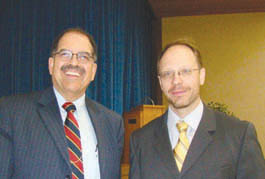Staff Report

Photo: Edward Ashjian
This month, Dr. La Porta gave a series of talks to local and regional groups on Armenian topics. On April 13, he spoke at the annual dinner in commemoration of Armenian Martyr’s month for the First Armenian Presbyterian Church Men’s fellowship. He spoke about the significance of martyrdom in the early Armenian Church. He drew attention to the stories of St. Thaddeus and St. Sandukht, noting that the changes made in the Armenian version of the life of St. Thaddeus in which he is martyred in Armenia bring into relief the importance of such acts for early Armenian Christians. He also suggested that the imprisonment of St. Gregory the Illuminator represents a symbolic martyrdom.
Gregory’s torture, imprisonment, and release from Khor Virap, according to Dr. La Porta, imitates Christ’s torture, crucifixion, descent into the underworld, and ascent. Like Christ, he added, Gregory returns more triumphantly than he entered: “he was thrown into the pit for being a recalcitrant member of King Trdat’s secretariat, but he returns as Trdat’s healer and Armenia’s savior.”
Dr. La Porta’s next lecture took place on April 18 at the AGBU’s annual luncheon held at the St. Paul Armenian Church Berberian Hall, where he lectured on the Armenian presence in Jerusalem and Jerusalem in the Armenian imagination. He highlighted the long historical contact Armenians have had with Jerusalem from the fourth century until the present day. He drew attention to the spiritual attraction Jerusalem held for Armenians as a place of pilgrimage as well as a center of scribal and theological activity. He also discussed the present status of the Armenian population of Jerusalem and took the audience on a “virtual tour” of the Armenian Quarter of the Old City and of Armenian sites in the Church of the Holy Sepulcher.
Finally, on April 27, Dr. La Porta lectured at Sonoma State University as part of their 27th Annual Holocaust and Genocide Lecture Series. In addition to presenting the historical context of the Armenian Genocide and its execution, he pointed out the incredible relief efforts launched by the United States during and immediately after the Genocide. He observed, however, that such efforts were quickly forgotten as American political interests replaced her prior moral commitments.
Dr. La Porta also indicated the contemporary geopolitical relevance of the Armenian Genocide and its recognition, and its importance in our understanding of other genocides and for the prevention of future genocide. He cautioned, however, that the use of Genocide recognition as a political weapon to punish or reward the Republic of Turkey is a dangerous tactic as it undermines both the moral and legal status of genocide. He further added that it has been precisely the use of Genocide recognition as such a tool that has correctly raised suspicions among diasporan Armenians with regards to the creation of a historical commission to investigate the tragic events of 1915.
If, Dr. La Porta argued, the very recognition of the Armenian Genocide as genocide is capable of being bartered in order to further the political aims of particular interests, then what assurance can there be for an “apolitical” historical commission created within the very same framework?
Dr. La Porta’s next public lecture will take place on May 7 at the Charlie Keyan Armenian Community School on the topic of “How and Why the Armenian People have survived.”
 Hye Sharzhoom Armenian Action
Hye Sharzhoom Armenian Action